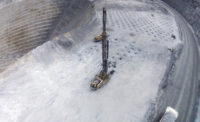A little over nine years ago, I received a call from a fabricator in North Carolina who said he had not only one, but TWO computer numerically controlled (CNC) stoneworking centers for residential countertop production. Intrigued by this virtually unprecedented development in this country's stone industry, I immediately made arrangements to drive down to this gentleman's facility so I could see the wonder of these machines in action. At the time, I felt it was truly a development that had to be seen to be believed.
And after driving nine hours, there they were - two gleaming Italian-made CNC stoneworking centers processing granite kitchen countertops. The beaming owner of these machines stood proudly alongside of his equipment, truly a king among men.
Of course, times have changed since then, and even though the CNC machines are a major investment, it is not at all uncommon to see shops with two or even three CNC stoneworking centers in their operations. They are not only being used by the top fabricators in each region; they are found in fabrication shops of all sizes throughout the country.
And while the debate continues as to what is the right time and situation to invest in CNC technology, there is no question that this machinery plays a major role in our industry today.
So what technology is on the horizon now? What is the next revolution that is currently developing in our industry? If you are walking through one of the trade shows, it would appear to be digital templating technology, as well as digitizing boards and advanced computer programs for use by fabricators. There are more companies marketing these products to the stone industry than ever before.
But in speaking to the fabricators in the field today, it seems that this technology has not been overwhelmingly embraced by the trade. Many shops - including ones that have been using CNC technology for some time now - are still using hard templates in their operations. Additionally, some of the companies using hard templates are not using digitizing boards to program their CNC units, and fabricators doing major volume do not have specialized job tracking software. Their reasons for not investing in this technology are quite similar to the explanations we heard for not purchasing CNC equipment in the mid-to-late 1990s (and sometimes still today). “It's too expensive.†“It's too hard to learn.†“We are fine doing things the way we are.â€
I am not saying that there is anything wrong with these explanations. In fact, many companies who invested over their head when it came to CNC technology are out of business today. So the choices need to be prudent, and more importantly, they must offer tangible benefits to your operation in terms of reduced costs or increased production, quality or efficiency.
However, our industry needs to keep an open mind to the new technology that can be found in the marketplace, even if it seems foreign and confusing to them at the moment. Our competitors (i.e. fabricators of manmade countertop materials) already employ much of this technology, so we need to keep pace when it makes sense from a practical standpoint.
Remember how much of a hassle digital cameras seemed when they first came out (at least for me and some other members of the 35-and-older crowd)? Now they're the standard for high-quality photography today. I think it will be the same with some of the new technology in the marketplace for stone fabricators, and many people agree.
When I moderated the Fabricators Forum at Coverings 2006 (page 132), one of the speakers pointed out that the number of participants using digital templating technology increased from one person in 2005 to around a dozen in 2006 (out of around 75 people present). And while this is far from the majority, it represents a major increase and a trend that will continue to grow in the very near future.
Stone Column: What's the next step?

